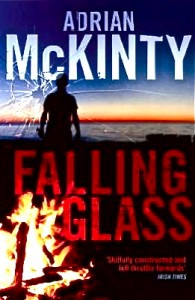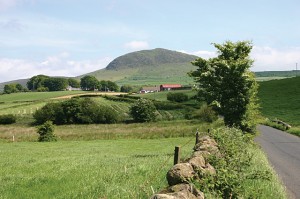“While we are on the subject of the shamrock, what’s with the four leaves?…The Celts are polytheistic, they have many gods, Saint Patrick wants them to worship one god so he employs the shamrock to represent the Trinity; God the Father, the son, and the holy Ghost. The Trinity. Three leaves. A four-leaf shamrock isn’t a shamrock. It’s a four-leaf clover.”—Killian, annoyed, in an Irish bar in New York, on St. Patrick’s Day.
 Originally from Belfast, forty-year-old Killian has tried to remake his life, having emigrated to New York City after spending his first twenty-three years in The Life in Belfast. A tinker, or Pavee, sometimes even referred to as a gypsy, Killian was involved in crimes of many varieties, including drugs, extortion, and even murder there, but he managed to get out of that life, learn to read, go to college, study history and the arts, and live a more “normal” life. Or what he sees as normal. He still adheres to his aboriginal values:
Originally from Belfast, forty-year-old Killian has tried to remake his life, having emigrated to New York City after spending his first twenty-three years in The Life in Belfast. A tinker, or Pavee, sometimes even referred to as a gypsy, Killian was involved in crimes of many varieties, including drugs, extortion, and even murder there, but he managed to get out of that life, learn to read, go to college, study history and the arts, and live a more “normal” life. Or what he sees as normal. He still adheres to his aboriginal values:
“We [Pavee] live two lives. A life here on Earth in what we call the real world and a life in The Dreaming which is really the real world, where everything has a purpose, where we are more than thinking reeds, are part of some great scheme of things.”
 Author Adrian McKinty, who grew up in Carrickfergus, Northern Ireland, before emigrating to New York City, where he lived for over five years, endows both New York and Ireland with life as he creates a sometimes likeable, though often violent main character, a man unable to abide by the rules set by governments for society, a man who, instead, lives by his own inner code and a more vengeful sense of honor and justice. Having not learned to read until he was an adult, he had no opportunity to study or explore the philosophical or academic origins of society’s laws, but
Author Adrian McKinty, who grew up in Carrickfergus, Northern Ireland, before emigrating to New York City, where he lived for over five years, endows both New York and Ireland with life as he creates a sometimes likeable, though often violent main character, a man unable to abide by the rules set by governments for society, a man who, instead, lives by his own inner code and a more vengeful sense of honor and justice. Having not learned to read until he was an adult, he had no opportunity to study or explore the philosophical or academic origins of society’s laws, but
“the tinker code did not rely on paper. Your word was everything…Duty was more important than right. You fulfilled your obligations above all else. Even unto death…” Though he admits that he has read “thousands of books” since learning to read as an adult, he still believes that “You are where you came from. There are no disembodied selves…In the Pavee code of honour a life is given meaning by the narrative each narrator imposes on himself within the story.”

Pearl River, Kowloon
Unfortunately for Killian, his own story involves a real estate investment he made in Belfast which has gone bad with the economic downturn, and he is now seriously in debt. When he is contacted in New York by an old “mate” from Belfast, now relocated to Boston, to collect a debt from someone in New Hampshire, he sees this as a chance to get out of his own debt. He has no choice but to accept. In an unusual twist, he “refinances” the man’s debt and solves his own problems at the same time. Soon he is off to Kowloon to meet with Richard Coulter, an extremely wealthy and influential Irishman who wants to hire him to find his ex-wife Rachel and daughters, ages five and seven, missing or hiding somewhere in Northern Ireland. He offers an enormous sum if Killian is successful. Soon the “retired” tinker is back in Belfast and back in The Life.
For Coulter, “Everything is at stake,” as he faces a crisis so important that he has divided it into two parts. Killian’s job will end as soon as he succeeds in finding Rachel Coulter and the girls; someone else will be hired for the mysterious “real job” after that. The reader quickly discovers that Coulter’s need to find Rachel is greatly in excess of what one would normally expect in an ordinary custody dispute, though the author draws out the suspense for almost half the book, hinting early about a laptop but not revealing why this is so important – and not just to Coulter. The plot, however, remains squarely focused on Killian’s job and the search for Rachel and the girls, who are hiding in a caravan park and eventually on a remote, virtually uninhabited island in Lough Erne.

Lough Erne
As Killian searches, he is often tailed by a man from Volvograd named Markov, also called Starshyna, a violent man responsible for eight or nine gruesome murders of Mexicans, along the US/Mexico border. These nauseating murders are included, I suppose, to give a sense of just how debased and pathologically vicious Markov is, but they were so unsettling and seemingly so gratuitous that I came very close to giving up on this book. Markov has been hired for the “real job,” once Killian finds Rachel and the girls, and he is willing to do anything to Killian to ensure that he can finish the job by finding the mysterious laptop which Killian knows nothing about. And if Markov finds Rachel before Killian does, he is even better off – he will collect for both parts of the job. When the two men finally square off, Markov, having immobilized Killian, tells him, “They call me Starshyna. It means sergeant. I am what you can never be. I kill you, but you are very old man. I take pity on you. I let you live…You retire now. You are Jay Leno. I am Conan O’Brien.”

Slemish Mountain, where St. Patrick had been a slave. Near where Rachel's parents live.
Needless to say, Killian continues to try to help Rachel and her little girls, and the battle of wits between him (often violent) and Markov (even more violent and also sadistic) keeps the action moving quickly. As points of view change among Killian, Rachel, and Markov, the author also provides information about post cease-fire Ireland as Killian knows it – “drugs, new houses, and McDonald’s” – and further describes the social conditions: “In Ulster there are at least two- to three hundred convicted murderers walking the streets these days…paramilitaries who have been released under the Good Friday Agreement.” As for the tinkers and Pavees, so many of them have taken advantage of government housing that only two thousand to three thousand of them are still wanderers, though they still have their own code and culture. The social information sometimes feels a bit artificial and grafted onto the novel, but Killian’s personal illustration of the Pavee way of life makes these statements less intrusive than they might otherwise have been.
Ultimately, McKinty writes a dramatic and often shockingly dark thriller which casts new light on Northern Ireland in the aftermath of the years-long war against their counterparts to the south. The author’s inclusion of an Epilogue brings all the loose ends together and provides insights into the universal themes which the author sees in the narrative, a narrative of the real world as seen in The Dreaming.
Photos, in order: The author’s photo may be found here: http://www.irishecho.com.au
Pearl River, Kowloon, is from http://everspringtravel.com
The Lough Erne photo of its many islands, some with few, if any inhabitants, appears on http://www.todaysgolfer.co.uk
Slemish Mountain, near Broughshane, where Rachel’s parents live. This mountain, where St. Patrick was a slave for seven years, is considered a haunted and unlucky place. See: http://www.virtualvisit-northernireland.com
ARC: M. Zegarek PR
